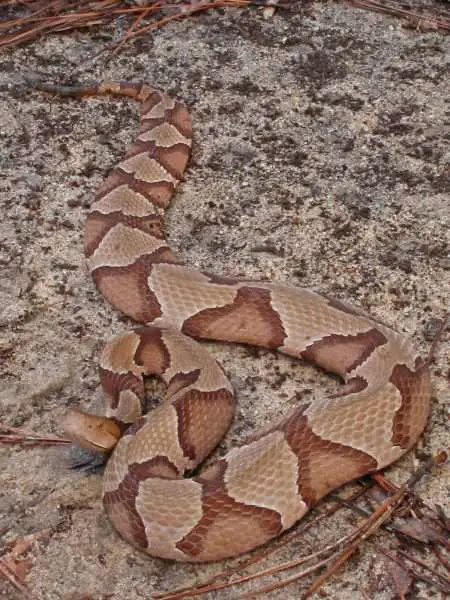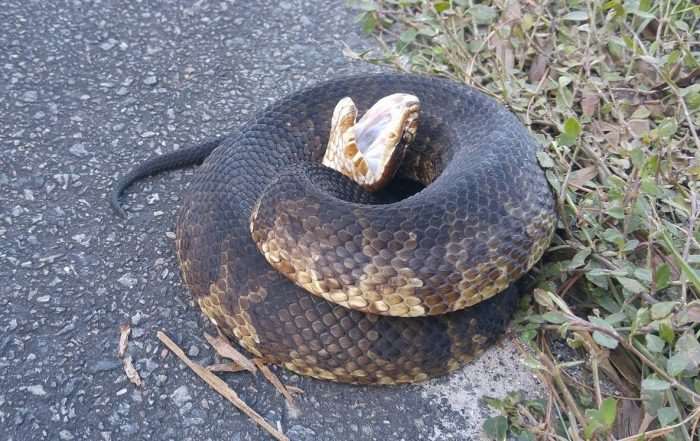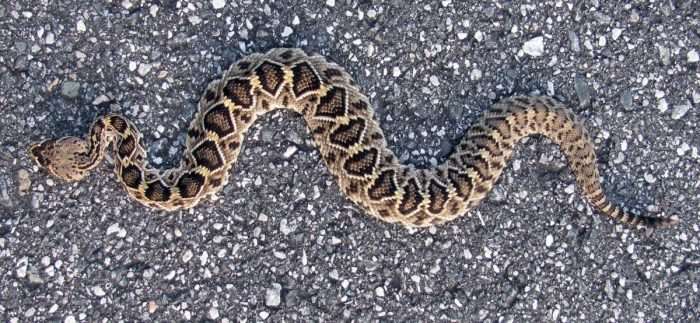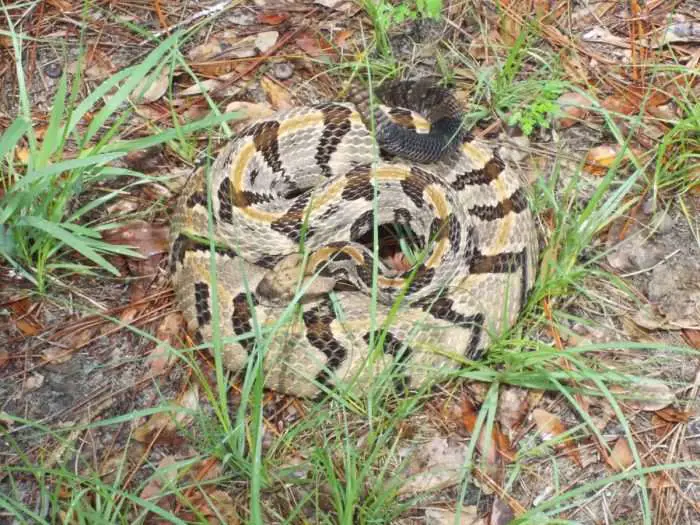This article came to life after an interaction with what I thought at the time to be an injured snake. As a lad who loves animals, I’m the type who will stop on a bike ride or in my vehicle, to render assistance to a healthy or injured animal, if I happen to see them by the roadside – gravel or pavement.
On September 26, 2017, I was riding with friends during the late afternoon hours of the day. As our quartet rolled into the south side of Gainesville, Florida, I spotted what I thought to be an injured snake taking up residence in the bike lane. Most snakes I have encountered on a bike ride typically head for cover the moment they sense the vibrations of the front wheel and tyre combination. But, this snake wasn’t moving. As we neared the snake, we took evasive action and gave it a decently wide berth.
I was approximately two feet from the snake as I passed on by. No problem I thought, until the snake took an opportunity to strike at me. Its strike was off target and out of range, but close enough to put a little bit of fear into me. I turned my head to look behind, expecting the snake to have slithered off into the woods. Rather, that snake was staying put in the bike lane. I may be an Australian bloke residing in the United States, but my years in Australia were spent avoiding snakes and sharks. Thus, my knowledge base is pretty poor.
When I took it upon myself to avail the snake of its current location with the help of a nearby desiccated palm frond, it was no wonder this snake seemed a little bit upset. It didn’t strike at me, but it did hiss a little, and kinked its head at a sharp angle towards the sky, mouth open. This stretch of pavement on the edge of town can get busy, and as each vehicle whizzed on by, its wake would greatly bother the snake. The hissing continued, head tilted towards the sky, mouth wide open. But the snake made no attempt to head into the woods.
This is where my ignorance could have landed me in trouble. My good friend Rob, aka Nature Boy, is my go-to person for the identification of snakes. At the time, Rob was riding his bike and not answering his phone. Fair enough, right. I made the questionable decision to snap some closeup photos of the snake, fearing it was injured, but hoping those photos would give Rob an idea of the snake’s injuries – and whether it was worth trying to save. Yet in reality, I was moving into its strike range. Fortunately, the snake made no real attempt to move or strike, once again leading me to think it really was injured. But, I was fortunate again as this was a Cottonmouth… in its classic strike pose, as indicated from my photo taken further down in this article. Rob later confirmed the snake’s identity from the photos I sent at the scene.
So, what’s the moral of this story? Educate yourself about your environment. Don’t make assumptions. Err on the side of caution. You may have a snake encounter similar to mine, but give it a wide berth and go on your way. Don’t take close up photos and don’t tempt fate!
With that said, it’s time for my friend Rob to chime in about the snakes that reside in Florida, the home state of the Gravel Cyclist crew. Make yourself aware of the wildlife in your area too.
There are fifty snake species in Florida—home range of the Gravel Cyclist. Only six are venomous. It is worth pointing out: none are poisonous. Poison is something that when ingested makes you ill, whereas, venom begins its mischief via a forceful introduction by fangs, a spine, a stinger, or in rare cases—maybe when your luck is exceedingly low—sprayed into your eyes. Ouch! The purpose of this article is to help the cyclist in Florida identify and appreciate the beauty of these snakes and to learn a little of their natural history. Snakes of all kinds show incredible forbearance in their interactions with humans and humans that respond in kind are better for the experience. Still, it must be emphasized that a bite from any of Florida’s venomous snake species, albeit exceedingly unlikely to occur, constitutes a medical emergency and must be treated as such.
With that out of the way: There are two major groups of venomous snakes, which if you are fortunate and observant, you are eventually going to see while cycling in the realm of the Gravel Cyclist. These are the Pit Vipers and the Coral Snakes.
Pit Vipers
Family Viperidae
Five of the six venomous snakes in Florida are pit vipers. What’s a pit viper? A viper with a heat-sensing pit between the eye and nostril. Natural selection has shaped serpent morphology in all kinds of cool ways and the heat-sensing pit organ of pit vipers is just one such remarkable adaptation. Functioning as a gauge of the relative temperature of objects in the environment, the pit organ helps a pit viper determine the location of animals that could be predator or prey.
In the New World, there is no kind of viper other than pit vipers. And for North Americans living north of Mexico, pit viper translates to Rattlesnakes, Cottonmouths, and Copperheads. The most diverse and distinctive of these are the rattlers. In Central and South America, exotic forms of pit vipers such as Cantils, Eyelash vipers, Lance heads, and Bushmasters populate the landscape (rattlers too). In some areas of the Old World, one finds both pit vipers and the true vipers (no pits) but there are no vipers of any kind in Australia—birthplace of the Gravel Cyclist. What the land down under lacks in vipers though, it makes up for in a bewildering array of elapids, the group to which Florida’s sixth venomous snake belongs… but we’re getting ahead of ourselves here.
So without further ado, here are your five pit vipers and how to recognize them, whether their coils be animate or whether they be shuffled off their mortal coil, sadly, and splat on the road.
EASTERN COPPERHEAD
Agkistrodon contortrix

How to identify: The Eastern Copperhead has a copper to rust-colored head, and a beige or grayish-tan body with darker colored bands that are widest on the lower side and narrowest on the back. These bands frequently fail to meet one another evenly on the back. Pro tip – knowing native range is a really useful identification tool. In Florida, the Eastern Copperhead is only found in a few North Florida locales. The most likely places for an encounter are the western edge of the Panhandle and the vicinity of the Apalachicola River Basin. Adults are typically 24-36 inches.
Fun fact: Juvenile Copperheads and Cottonmouths (see below) are born with bright yellow tail tips that they use to lure prey.
FLORIDA COTTONMOUTH
Agkistrodon conanti


How to identify: This is probably the most difficult venomous snake in Florida for the layperson to identify. The color palette is similar to a number of harmless water snakes. And while many of our harmless water snakes have distinct patterns (different from color) both groups can get mud-covered, making body pattern unreliable. The best features for identifying the Florida Cottonmouth are the dark stripe through the eye bordered by light-colored stripes above and below, and two dark vertical bands on the snout. When threatened these snakes will open their mouths revealing the bright white interior for which they’ve been named. If you’ve got a for-sure-dead one on the road in front of you, what herpetologists call “DOR” (dead-on-road) – look for the pit viper pit! If the snake is alive—do not get so close!
The Florida Cottonmouth can be found anywhere in the state and is probably the venomous snake you are most likely to notice while cycling in Florida. They really like to be near water, but don’t count them out anywhere. Adults are typically 30-48 inches.
Fun fact: Cottonmouths will eat appropriately sized road kill.
EASTERN DIAMONDBACK RATTLESNAKE
Crotalus adamanteus

How to identify: The Eastern Diamondback is North America’s largest venomous reptile. Variable in color, it is predominately gray or gray-silver to charcoal or brown with a series of large diamond-shaped markings outlined in white to cream on its back. These diamonds tend to be more indistinct on the back half of the snake.The Eastern Diamondback is distributed throughout the state but its populations are in decline owing to habitat loss and wanton killing by people. Should you encounter a live, adult Eastern Diamondback that is aroused to defend itself in the classic coiled posture, with fore body aloft, and rattle at work—keep your distance and consider yourself lucky. It is a sensory-experience unlike any other nature has to offer. Adults are typically 48-72 inches.
Fun fact: Rattlesnakes are born with a “button” on their tail, the first in a series of the rattle they develop with each successive shed. (The Catalina Island Rattlesnake, Crotalus catalinensis is an exception to this rule). Rattles can be damaged and segments lost and rattles are not a reliable indicator of age.
TIMBER RATTLESNAKE
Crotalus horridus

How to identify: A light grey to beige colored snake with black chevrons on its back and typically, a rust or mustard colored stripe down the center of the back. Known by many in the South as the Canebrake rattlesnake, this species, like the Copperhead, reaches the southern limit of its range in the Eastern United States in Florida. While recorded as far south as Marion and Volusia counties, it is more common in Alachua County and points north. It can be found in some locations in the Florida Panhandle. Our other “big” rattler, adults are typically 36-60 inches.
Fun fact: Benjamin Franklin adopted the Timber Rattlesnake on numerous occasions as a unifying symbol for the American Colonies, with great effect, observing: “She never begins an attack, nor, when once engaged, ever surrenders: She is therefore an emblem of magnanimity and true courage.” Today, fearful ignoramuses kill this snake and others like it out of cowardice and a lack of respect for American history.
DUSKY PYGMY RATTLESNAKE
Sistrurus miliarius barbouri

How to identify: A small rattlesnake with a rattle that sounds like a buzzing insect, the Dusky Pygmy Rattlesnake is gray to light gray or charcoal in color. These tones are almost asphalt colored—usually just a few shades darker than the road you might see it on. There are 1-3 rows of black spots on the side and a series of small black saddles on the back through which runs a reddish to rust-colored stripe. Adults are typically 12-24 inches.
Fun fact: What the Dusky Pygmy Rattlesnake lacks in size, it makes up for in feistiness. While the author has seen this species unwittingly trodden upon by his sandal-wearing field companion with not even a snap of protest in retaliation, it may be the snake was as surprised as we were by the encounter. Conversely, of all the venomous snakes I ever kept in captivity (all on this list and many exotic forms) – this is the only one to ever “pop” me and I only had to make a mistake once. Like all snakes, it would rather flee than fight, but do not take liberties with this snake because of its diminutive size.
Coral Snakes
Family Elapidae
Coral Snakes are an exclusively New World radiation of an Old World group, the Elapidae. Elapids are a speciose group of venomous snakes represented by a phenomenal array of morphological diversity. The elapids are the dominant group of venomous snakes in the Gravel Cyclist’s native Australia. The best-known elapids there include the Taipans, the Death Adders, and the King Brown. In Africa the most recognizable members of the family are the iconic Cobras and the Mambas; in East Asia, the King Cobra and the deceptively placid-by-day Kraits.
HARLEQUIN CORALSNAKE
Micrurus fulvius

How to identify: A slender-bodied, blunt-headed snake with small eyes, the Harlequin Coralsnake is ringed in black, yellow, and red from snout to tail tip. Two nonvenomous species with similar coloration are easily distinguished. Only the Harlequin Coralsnake (formerly known as the Eastern Coralsnake) has a black snout (red in the others) and yellow bands touching red ones.
Fun fact: The Harlequin Coralsnake is fossorial, spending most of its time underground or in leaf litter where it preys on skinks (a type of lizard), small snakes, and the worm-lizard (Rhineura floridana). When disturbed it may engage in “cloacal popping.” There are “dangers” from both ends of a snake: Look it up, it is gross, but pretty cool too.
A Word About Venomous Snakes and Humans
This article is for the cyclist riding in Florida that appreciates wildlife and for those that want to know more about the snakes they sometimes encounter. All of our native snake species are important wildlife which has a role to play in Florida’s natural ecosystems. Additionally, many snakes do us a good turn in the areas we’ve developed for human habitation by controlling populations of other organisms we label as pests, yet which are attracted by our activities (e.g., rodents that forage on our waste or insects that happily munch your carefully cultivated petunias).
Snakebite in the United States is not nearly the medical problem it is in the developing world. Research shows that in the United States 85% of bites are to the upper extremities, males are 7-9 times more likely to be bitten by females, 82% of those bitten are aged 10 -30, and that at least 28% of victims are intoxicated at the time of the bite. Thus, the take-home message is that snakebite is a rare event that happens disproportionately to the hands of young, oftentimes drunk males, trying to capture, molest, or kill a snake. Those of us who observe venomous snakes while exercising common sense need not worry about the danger of their presence, though all of us could stand to consider the losses we’d experience in their absence.
A word about the author: “Nature Boy” aka Rob Robins is a career ichthyologist (one who studies fishes) who took a lot of enjoyment out of a lot of herpetology classes (reptiles and amphibians), freely and openly admits to consorting with real herpetologists, and has kept snakes as a hobby for 27 years. He was a licensed keeper of venomous reptiles for twelve of those years (“the complete idiot years”) until he found cycling a better outlet for his destructive tendencies.


Very interesting! I saw a small king snake in Arizona, while riding the bike. I wrote an article on my blog: https://levelomanevintage.blogspot.fr/2016/08/a-velo-au-far-west.html?m=1
Here in France, we just have vipers which are venomous.
Another reason to live in Michigan. Yikes !
JOM knows that EVERYTHING in OZ is highly venomous….
Snakes: taipans, black, brown, tiger etc
Spiders: Redback, Sydney funnel-web, and even whitetail
Box jellyfish, blue ringed octopus, stone fish, Molly Meldrums, Great White, bull, tiger sharks….however,
The most terrifying, the most primordial savage and bloodthirsty creature is the dreaded Dropious Ursidae. These beasts hunt in packs and inhabit clusters of Eucalypt trees
both in the wild and of late more frequently popular tourist destinations, where they will drop down from their leafy dens and shred unsuspecting hapless victims to a most grisly death, before dragging the bloodied remains to high branches to engorge themselves…..
Yes… the dreaded drop bear.
The Molly Meldrum reference may be lost on a few people 🙂
Heck, my elementary school backed up to the Merritt island National Wildlife Refuge and we used to catch rattlers, moccasins, and coral snakes for show and tell. Part of growing up in 60’s era Florida.
JOM your story made me chuckle as I kind of did the same thing. Many years ago on one of the Colorado week long roadie tours probably Bicycle Tour or Colorado or Ride the Rockies they had their day off mid week at Steamboat Springs. Being the outdoorsy guy I did some checking and yes they had this great hiking trail there Mad Creek trail head. I get to the school call a taxi and have them take me to the trail head with arrangements to pick me up the next morning at 4 AM. Hike up the trail and set up base camp. Do some more hiking and in the afternoon camping back to camp there was a snake sunning on the trail. It’s too cold in Colorado to have rattlesnakes right as that is what it looked like. I was going to go down into the woods looking for it and glad now that I didn’t as I found out afterwards yes Colorado has rattlesnakes. I have copperheads and rattlesnakes here in Pa. and the copperhead is a more aggressive snake. Having been over to Aussie land once I know the brown snake is an aggressive snake there. You are right in that yo need to know what snakes live in your area. Good article.
When I worked in Tasmania a few years ago, I Googled non-poisonous snakes of Tasmania, and got a blank page. That makes it easy to decide if a snake in Tassie is dangerous – they all are. One of the guys in an MTB race that I did got bitten during the race. He did fine and only got mildly ill.
Uhh, try and be safe Jayson…
Saw the biggest snake of my life on the Hawthorne trail after some major rain… Thought the thing was an alligator, or godzilla! It was truly enormous.